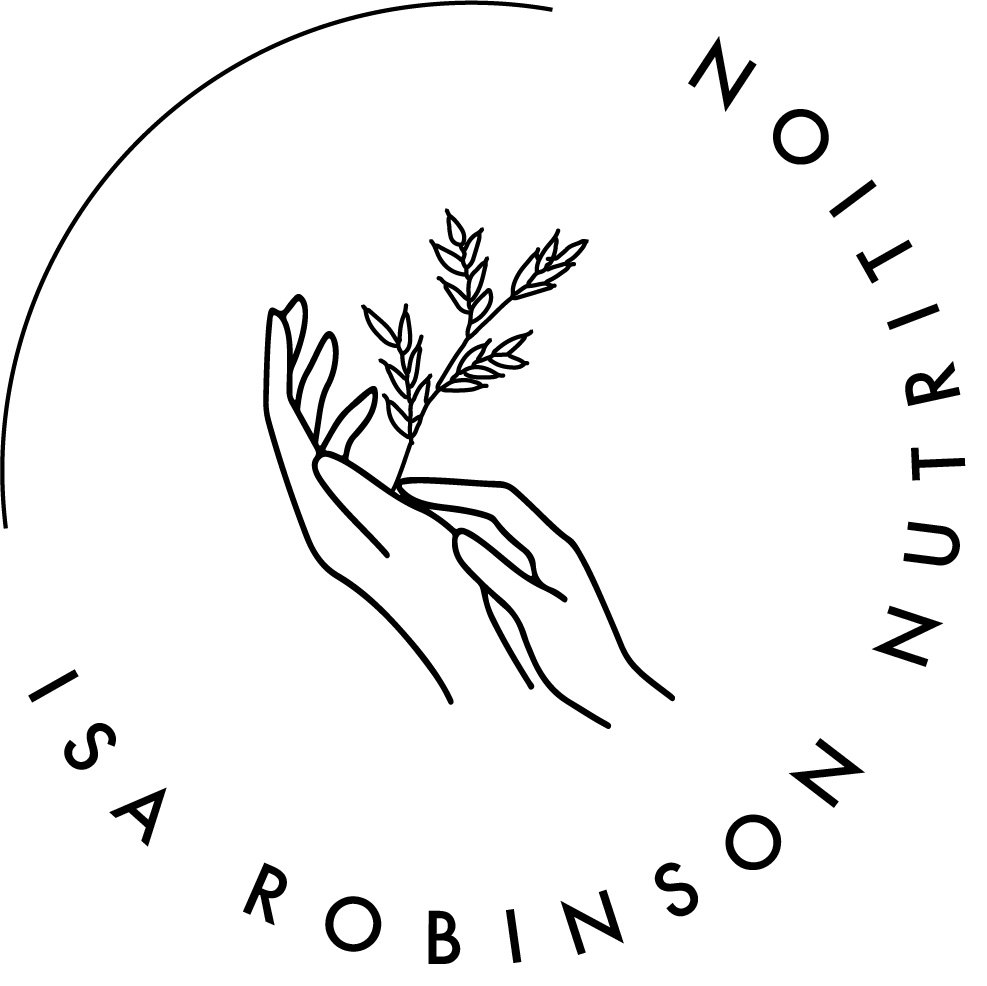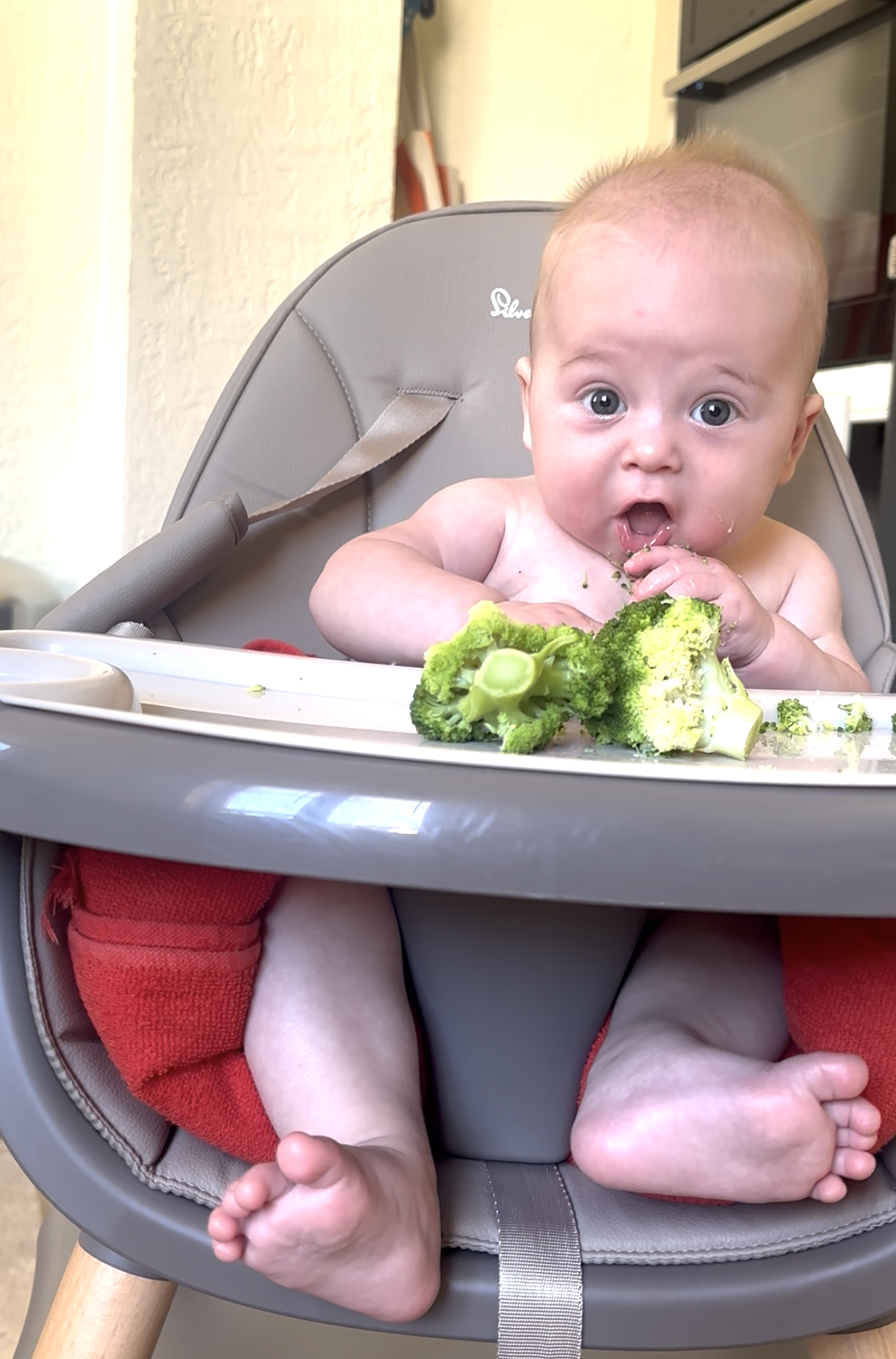A Cheat’s Guide to Weaning: Evidence-Based Answers to Your FAQs
Starting the journey onwards from milk to real foods is an exciting milestone, but it can also feel overwhelming (even for a qualified nutritionist). From baby-led weaning (BLW) and choking risks to allergens and salt limits, there’s a lot to take in. This guide brings together clear, evidence-based answers to some of the most common weaning questions and certainly the ones I had.
What is the Difference Between Baby-Led Weaning and Responsive Feeding?
Baby-led weaning (BLW) is a method of introducing solids that skips purées and spoon-feeding in favour of allowing babies to self-feed soft finger foods from around six months. It promotes autonomy and encourages exposure to a variety of textures and flavours from the outset.
Responsive feeding, by contrast, is a broader approach. It refers to tuning into your baby’s hunger and fullness cues —whether that’s via spoon-feeding, self-feeding, or a combination of the two. It aligns with the principles of BLW but isn’t tied to a specific feeding style.
In practice, many parents (including myself) follow a combination approach—offering both purées and whole pieces of food, guided by their baby’s interest and development.
Source: Pérez-Escamilla et al., 2017. Nutrition Today. PMID: 28863050
Here we offered both courgette as a finger food and purée.
Do You Have to Start with Purées? What Are the Advantages and Disadvantages?
Purées are a popular starting point, but they’re not essential. Baby-led weaning involves skipping purées in favour of soft, graspable finger foods. Some families who follow BLW will talk about their baby suddenly picking up food off theirs or a siblings plate and this being an indication they were ready rather than going through the process of purées.
Advantages of BLW:
Encourages independence and self-regulation
Supports fine motor skill development
May help babies better regulate appetite
**All of these can however be achieved if you feed responsively e.g. letting babe self-feed purees on a spoon.
Disadvantages:
Can be messier
Food intake may be slower initially
Potentially more gagging, though this is normal and part of learning to manage textures
Source: Cameron et al., Appetite. 2015. PMID: 25933450
Do You Need to Start with Fruits or Vegetables?
No!
You can start with fruits, vegetables, or other foods such as yoghurt, eggs, chicken, or lentils—as long as they are prepared appropriately and your baby is ready.
There are recommendations to start with bitter vegetables (e.g. broccoli, spinach, courgette) to help shape taste preferences and encourage a more varied palate. There is some research to suggest that early exposure to a wide range of flavours, particularly less sweet ones (which are always usually well accepted), may support better food acceptance later on.
That said, there’s no requirement to begin with fruits or vegetables only. Foods like well-cooked meat, plain full-fat yoghurt, and pulses offer valuable protein, iron, and healthy fats, as well as different flavours and textures which are all crucial during the weaning period.
References: Hetherington et al., Appetite. 2015. PMID: 25450943; Chambers, Curr Nutr Rep. 2021. PMID: 34097061
How Do I Know If My Baby Is Developmentally Ready?
Babies are usually ready to start solids at around six months—but developmental readiness is more important than age alone. Look for the following signs:
Able to sit upright with minimal support
Good head and neck control
Loss of the tongue-thrust reflex
Hand-to-mouth coordination
Interest in food (watching others eat, reaching for food)
These signs suggest your baby can safely explore solids and begin learning about food through touch, taste and interaction—not just for nutrition, but also for sensory and motor development.
Sources: SACN 2018; NHS Start for Life
Which Foods Are an Absolute No-No When You Begin Weaning—and Why?
There are some foods that are unsafe or unsuitable for babies during the weaning period:
Whole nuts and popcorn – choking hazard
Other choking hazards - more about that later
Honey (under 12 months) – risk of infant botulism
Added salt – can strain immature kidneys (max 1g/day sodium)
Unpasteurised cheese or milk – risk of bacterial infections (e.g. Listeria, E. coli)
Raw or undercooked eggs, meat or fish – unless eggs are Lion-marked
Rice milk (under 5 years) – may contain arsenic
The NHS also advises limiting sugar and sweetened drinks due to their impact on dental health but I’ve removed this from my list of “no nos”. While, I probably won’t be offering my 6 month old coca cola, a little bit of sugar here and there won’t harm them and is part of the social aspect of eating etc.
Sources: NHS Start4Life 2021; EFSA 2014; WHO Guidelines
Is There an Increased Risk of Choking with Baby-Led Weaning?
When practiced safely and appropriately, baby-led weaning does not carry a greater risk of choking than traditional spoon-feeding. To minimise the risk:
Offer only soft, age-appropriate finger foods (the free function on the Solid starts app is great for this)
Avoid hard, round, or sticky foods like raw apple, whole grapes, chunks of meat, or whole nuts
Ensure your baby is sitting upright and always supervised while eating
Strongly recommended to do a baby first aid course and refresh before starting weaning
Source: Fangupo et al., Pediatrics. 2016. PMID: 26791948
Are There Any Foods to Include in Moderation—and Why?
Some foods may be best offered in small amounts for specific reasons as indicated below:
Cheese – naturally salty; best in small portions. More about salt later.
Bread and crackers – may contain added salt
Tinned foods – often high in sodium; opt for low-salt versions
Dried fruit and fruit juice – high in sugar; better served with meals to protect teeth
Oily fish (e.g. salmon, sardines, anchovies) – nutritious but should be limited to two portions per week due to mercury content and salt, depending on the source
What Are the Salt Limits for Babies, and What Should You Look for on Labels?
Babies under 12 months should have no more than 1g of salt per day (equivalent to 0.4g sodium). Excessive salt can damage developing kidneys and increase future blood pressure risk.
When checking food labels, look for products containing less than 0.3g of salt per 100g. Common high-salt foods to be cautious with include:
Cheese (e.g. cheddar, feta)
Bread and toast
Olives and cured meats
Stock cubes, gravies and sauces
Tinned or canned foods such as tuna in brine, sardines, baked beans or soups
Some breakfast cereals
Sources: SACN 2018; NHS Start for Life
What Are the Common Food Allergens in Weaning?
The most common allergens to be aware of during weaning include:
Cow’s milk
Eggs
Peanuts
Tree nuts
Soya
Wheat (gluten)
Fish
Shellfish
Sesame
Source: Fleischer et al., Pediatrics. 2013. PMID: 23979084
First taste of yoghurt
When Is It Best to Introduce Allergens—and How?
Allergens should ideally be introduced from around six months, one at a time and in small amounts. If tolerated, they should be offered regularly to maintain tolerance. Waiting two to three days between new allergens can help spot potential reactions.
For babies with severe eczema, existing allergies, or a family history of allergy, seek guidance from a GP or allergist before introducing allergenic foods.
Research suggests introducing allergens between 4–6 months and no later than 6–12 months may reduce the risk of developing food allergies.
Source: Du Toit et al., NEJM. 2015. PMID: 25705822
And What About The Nutrition:
Until your baby is around 1 year old, milk (breast or formula) remain their main source of nutrition. Therefore the early stages of weaning are about exploration, play and learning new skills. The food can be considered “complementary feeding” — food is complementing, not replacing, milk.
Of course as your baby moves towards “meals” you can consider balancing these and offering variety much like you would your own. Variety means that you’'ll likely cover foods that contain some of the important nutrients for your baby’s growth and development including:
Calcium: breast milk / formula, full fat dairy, fortified plant based dairy alternatives, tofu, dark green leafy vegetables, nuts and seeds prepared appropriately
Iron: meat, fish, eggs, lentils, nuts and seeds prepared appropriately
If your baby is exclusively or predominantly breastfed, it is recommended to give a daily vitamin D supplement of 8.5–10 micrograms, as breast milk alone does not provide enough vitamin D for bone health and immune function. In additon, if you and your baby are following a vegan or vegetarian diet it may be recommended to work with a nutrition professional to ensure appropriate intake of nutrirents such as Iron, Calcium, Vitamin B12, Omega 3 and Iodine.
Sources: NHS Start for Life; SACN 2018; NICE Public Health Guideline PH56
Anything Else?
One of the most supportive things you can do for your child’s relationship with food and long-term health is to eat with them. Letting your baby see you eat and involving them at the table early on helps develop many foundational eating skills, including hand-to-mouth coordination and chewing. Modelling enjoyment of a wide variety of foods is far more likely to spark their curiosity than telling them something is “good for them.”
Understandably, it’s not always practical to eat every meal with your baby, but aiming for even 1–2 shared meals per week can make a difference. Alternatively, simply pulling them up to the table while you eat is a great start.
Research consistently shows that regular family meals are associated with a range of benefits for children, including higher intakes of nutrient-dense foods, and better mental and physical health outcomes as they grow.
Sources: References: Patrick & Nicklas, 2005; Fiese & Schwartz, 2008; Hammons & Fiese, 2011.
Final thoughts:
There’s no one ‘right’ way to wean. The most important thing is ensure weaning is fun (for you and your little one), that it’s undertaken in a way that keeps your baby safe and is responsive to their cues. Embrace the mess and whatever else you need to make it work for you.





